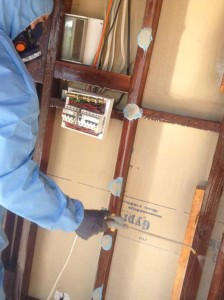How to Eliminate Mold From Every House Surface area
Mold spores are everywhere around us in every type of environment. Mold is fungis and some types are extremely useful to mankind (think about penicillin), while others can be rather dangerous to crops, breathing systems, and the stability of structures. Unsafe Mold vs. Mildew The most typical type of mold found in houses is mildew.
Mildew is a surface mold that grows in warm, moist places like your restroom and on materials and books stored in wet basements. Mildew starts as a gray or white grainy nest. It will turn black or brown if not removed promptly and frequently looks like soil build-up. To check if the surface is covered with mildew or just dirt, dab the stain with a cotton swab dipped in home chlorine bleach. If the stain lightens or disappears after two or 3 minutes, it's mildew. If not, it's most likely simply dirt. If you identify a musty smell anywhere in your house, then you have a high concentration of mold. It can be coming from a hamper filled with damp towels, from a damp crawlspace under your home, or carpets that have mold growing in the padding. It's certainly time to do something about it to get rid of the problem. Now you know that all mildew is mold however not all molds are mildew.
Mildew can tarnish and slowly harm surfaces but there are far more hazardous molds that can harm the structure of your house. If you see a black or green mold that is fuzzy or slimy and the drywall or wood underneath is soft or collapses, there is permanent rot and the mold and the broken surface areas need to be removed immediately.
Hiring Specialists If mildew problem is caught early, you can quickly handle it with household cleaners.
Warning For extensive mold problems, think about employing a mold inspection cost for apartment professional. Some molds are highly toxic and even less hazardous molds can cause issues for anyone with mold allergic reactions or compromised breathing systems. The rule of thumb is if the mold covers 10 or more square feet, hire an expert. Removing large mold colonies needs exposure to heavy-duty chemicals and appropriate disposal of infested structure materials.
Local public health departments can offer recommendations on mold screening and refer you to http://query.nytimes.com/search/sitesearch/?action=click&contentCollection®ion=TopBar&WT.nav=searchWidget&module=SearchSubmit&pgtype=Homepage#/Mold inspection a professional mold remover.

Products That Kill Mold Chlorine bleach: Sodium hypochlorite or routine family bleach works best to ruin mold and remove any staining. It is rather extreme and ought to be watered down before using.
Caution Care must be utilized due to toxicity and hazardous fumes and bleach must never be integrated with ammonia.
Hydrogen peroxide: Less severe than chlorine bleach, hydrogen peroxide (3 to 10 percent option) will kill mold and lighten stains. While it does have a whitening effect, it works more gradually than chlorine bleach but has no hazardous fumes or residue.
Distilled white vinegar: Vinegar is acidic and slowly breaks down the structure of mold and eliminates it. Vinegar is non-toxic however mold spots may remain and additional scrubbing with a household cleaner might be needed.
Baking soda and borax: Salt bicarbonate (baking soda) and borax each have a high pH that hinders the growth and survival of mold. Both items are low-cost, non-toxic, and easy to blend with water. Borax will work much better in eliminating any sticking around stains but not as effectively as a stronger cleaning product. When utilizing any of these products, do not wash away the cleansing option totally. Leaving a little the cleaner will assist prevent future mold development.
Removal from Fabric If your home has been flooded and mold and bacteria have actually been delegated grow for numerous days, it may be difficult to salvage fabric items. However, if mildew has developed due to wetness and is captured early, it can easily be gotten rid of from many materials. Begin by taking the items outside to brush away as much surface mold as possible and to prevent spreading out the mold spores inside your house. If the material is washable, use the most popular water recommended on the care label and add a disinfectant. If spots remain, create a service of oxygen bleach and water and enable the clothes to soak for a minimum of eight hours.
Oxygen bleach can be used securely on any washable fabric. For materials that are dry tidy just, brush away the mildew outside and after that head to an expert cleaner. Recognize and explain the stains and many materials can be successfully brought back.
Leather Shoes, Coats, Accessories, and Furnishings Mold on leather coats, shoes, purses, and furniture must be gotten rid of outside, if possible. Clean down the surface with a fabric dipped in distilled white vinegar and then with an excellent leather soap and warm water. Dry with a soft fabric and permit to air dry entirely. Once entirely dry, treat the item with a leather conditioner.
Books and Papers Mold will eventually damage paper but it can be effectively eliminated. For costly books and traditionally substantial papers, consult an expert manager. Never ever try to treat moist paper. The mold will smear and become almost impossible to eliminate. Permit the paper in books to air dry thoroughly in the sun or place in a sealed container with moisture absorbent material like silica gel or cornstarch sprayed in between the pages. When the book is dry, head exterior and utilize a soft paintbrush or fabric to gently brush away the mildew from the cover and each page. Slide a sheet of waxed paper under each page to protect the page behind it. A little moisten a clean, soft fabric with hydrogen peroxide and gently clean down each page permitting it to air dry entirely prior to transferring to the next page.